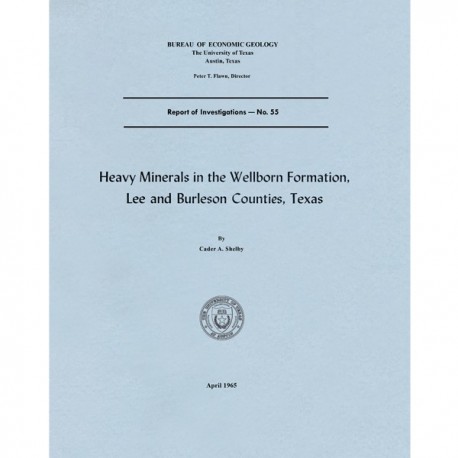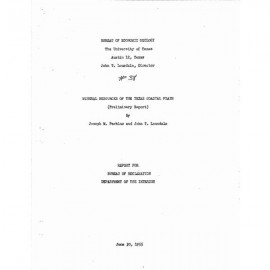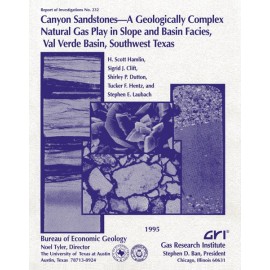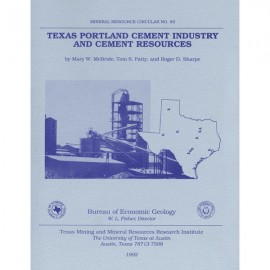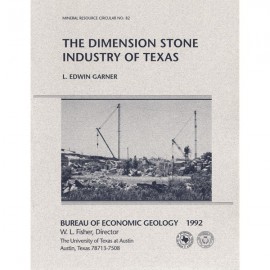Reports of Investigations
-
Books & Reports
- Reports of Investigations
- Guidebooks
- Udden Series
- Geological Circulars
- Down To Earth
- Atlases of Major Oil and Gas Reservoirs
- Texas Memorial Museum Publications
- Environmental Geologic Atlas of the Texas Coastal Zone
- Mineral Resource Circulars
- Other Reports
- Seminars and Workshops
- Handbooks
- Submerged Lands of Texas
- Symposia
- Annual Reports
- Open File Reports
-
Maps & Cross Sections
- Thematic Maps
- Miscellaneous Maps, Charts & Sections
- Geologic Atlas of Texas
- STATEMAP Project Maps
- Geologic Quadrangle Maps
- Cross Sections
- Highway Geology Map
- Energy and Mineral Resource Maps
- Shoreline Change and Other Posters
- Wilcox Group, East Texas, Geological / Hydrological Folios
- Bouguer Gravity Atlas of Texas
- River Basin Regional Studies
- Featured Maps
- Posters
- Teachers & the Public
-
Geological Society Publications
- Gulf Coast Association of Geological Societies
- Alabama Geological Society
- Austin Geological Society
- Corpus Christi Geological Society
- Houston Geological Society
- Lafayette Geological Society
- Mississippi Geological Society
- New Orleans Geological Society
- South Texas Geological Society
- GCS SEPM Publications
- Historic BEG & UT Series
Heavy Minerals in the Wellborn Formation, Lee and Burleson Counties, Texas
RI0055
Heavy Minerals in the Wellborn Formation, Lee and Burleson Counties, Texas, by C. A. Shelby. 54 p., 4 figs., 1965. ISSN: 0082335X:Print. Book. Print Version.
A free, digital version of this publication can be found on: Texas ScholarWorks
RI0055. Heavy Minerals in the Wellborn Formation, Lee and Burleson Counties, Texas, by C. A. Shelby. 54 p., 4 figs., 1965. ISSN: 0082335X:Print.
To purchase this publication as a downloadable PDF, please order RI0055D.
ABSTRACT
At five places along the outcrop of the Wellborn Formation in Lee and Burleson counties, Texas, anomalously high gamma radiation is associated with concentrations of heavy minerals. The most abundant heavy minerals are ilmenite, magnetite, and zircon. The radiation is emitted by some radioactive element in zircon. The intensity of the radiation and the areal extent of the radiation anomalies were measured by a scintillation counter.
The Wellborn Formation, composed of sediments deposited in near-shore environments, is characterized by cross-bedded sandstone lentils interbedded with montmorillonitic, lignitic shale and lignite. Heavy minerals in the lower part of the Wellborn are concentrated in thin sheets andwedges along cross-beds and in local patches and streaks.
There are about 4 million tons of heavy mineral-bearing sandstone with an average of about 2 percent heavy minerals, or 2-1/2 million tons with an average of almost 3 percent heavy minerals. Locally, ilmenite, magnetite, and zircon make up as much as 25 percent of the sandstone, although concentrations are too small to be considered as commercial deposits under present [1965] economic conditions.
Keywords: minerals, heavy minerals, mineral resources, Wellborn Formation, Burleson County, Lee County, Texas, economic geology
Citation
Shelby, C. A., 1965, Heavy Minerals in the Wellborn Formation, Lee and Burleson Counties, Texas: The University of Texas at Austin, Bureau of Economic Geology, Report of Investigations No. 55, 54 p.
